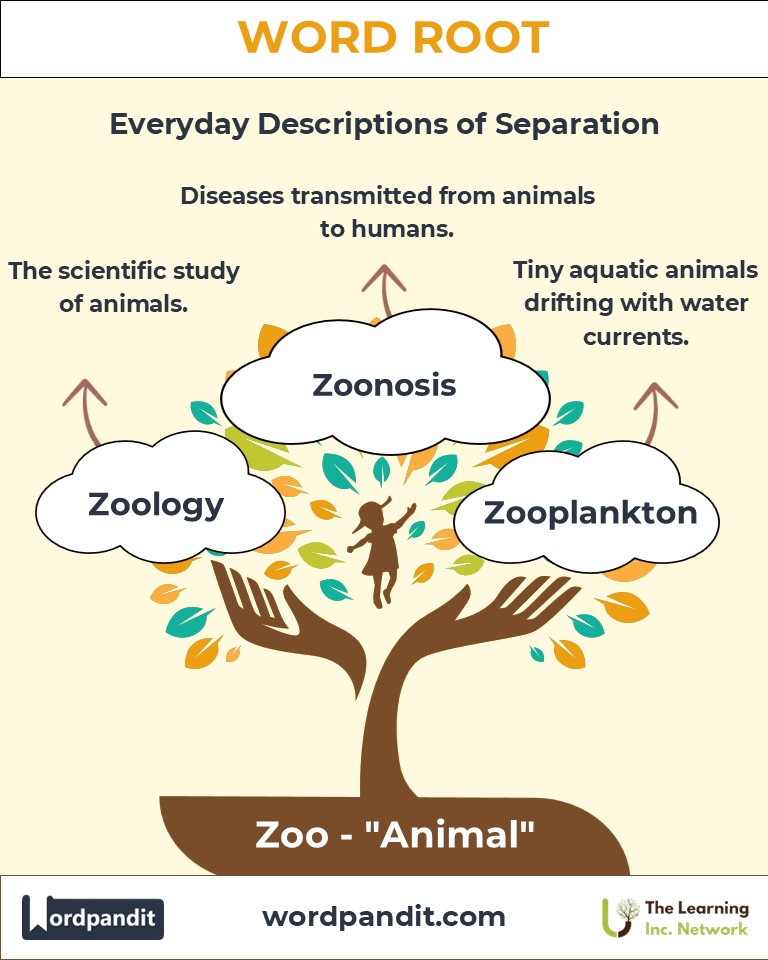Zoo: The Root of Life's Diversity in Language and Study
Discover the fascinating "Zoo" root, originating from the Greek word zōion, meaning "animal." From zoology to zoomorphic, this root reveals the dynamic relationship between humanity and the animal kingdom, shaping our understanding of life and its many forms.

Table of Contents
- Introduction: The Essence of Zoo
- Etymology and Historical Journey
- Mnemonic: Unlocking the Power of Zoo
- Common Zoo-Related Terms
- Zoo Through Time
- Zoo in Specialized Fields
- Illustrative Story: Zoo in Action
- Cultural Significance of the Zoo Root
- The Zoo Family Tree
- FAQs about the Zoo Word Root
- Test Your Knowledge: Zoo Word Root Quiz
- Conclusion: The Enduring Legacy of Zoo
1. Introduction: The Essence of Zoo
When you hear the word "zoo," you may think of a place where animals are kept, studied, or admired. But did you know that the root "zoo" extends far beyond this? Derived from the Greek zōion (pronounced ZOH-yon), meaning "animal," this root forms the basis of numerous scientific and cultural terms. From zoology, the study of animals, to zoomorphic art and design, this root captures the diversity and wonder of the animal kingdom.

2. Etymology and Historical Journey
The root "zoo" traces its origins to Ancient Greek, where zōion referred to any living being, particularly animals. Over centuries, the word evolved as a prefix in terms related to the natural sciences, particularly with the advent of taxonomy and biology during the Renaissance. By the 19th century, terms like "zoology" gained prominence, reflecting humanity's growing interest in studying and categorizing animals.
3. Mnemonic: Unlocking the Power of Zoo
To remember the root "zoo," imagine a bustling zoo filled with animals of all shapes and sizes, each representing a different word derived from this root.
Mnemonic Device: "Zoo reminds us of life’s diversity, from zoologists studying animals to zoomorphic designs in art."
4. Common Zoo-Related Terms
- Zoology (zoh-OL-uh-jee): The scientific study of animals.
- Example: "Zoology helps us understand the behavior and habitat of endangered species."
- Zoomorphic (zoh-uh-MOR-fik): Having the shape or characteristics of an animal.
- Example: "The ancient vase featured a zoomorphic design resembling a lion."
- Zoonosis (zoh-OH-noh-sis): Diseases transmitted from animals to humans.
- Example: "Zoonosis is a critical area of study in preventing global pandemics."
- Zooplankton (zoh-PLANK-tuhn): Tiny aquatic animals that drift with water currents.
- Example: "Zooplankton form the foundation of many marine food chains."
- Zootrophic (zoh-oh-TROH-fik): Feeding on animals, as in carnivorous species.
- Example: "Zootrophic organisms play a vital role in balancing ecosystems."
5. Zoo Through Time
- Zoology: Initially focused on classifying animals in the 16th century, it has expanded to include genetics, ecology, and conservation.
- Zoo: The word itself became popular in the 19th century as shorthand for "zoological garden," reflecting society's fascination with exotic wildlife.
6. Zoo in Specialized Fields
- Medicine:
- Zoonosis: Understanding animal-to-human disease transmission is crucial in epidemiology.
- Art and Design:
- Zoomorphic: Frequently used in sculptures, ceramics, and jewelry to convey animalistic qualities.
- Ecology:
- Zooplankton: Studied for their role in aquatic ecosystems and climate change research.
7. Illustrative Story: Zoo in Action
Dr. Eliza Bennett, a passionate zoologist, embarked on a mission to study zoonotic diseases in remote regions. Her work uncovered vital links between wildlife preservation and public health. Meanwhile, an artist in her village created zoomorphic sculptures inspired by Eliza’s research, raising awareness of endangered species. Together, they highlighted the interconnectedness of the root "zoo" in science and culture.
8. Cultural Significance of the Zoo Root
The concept of "zoo" has permeated art, literature, and entertainment. From ancient mythologies featuring zoomorphic gods to modern zoos promoting conservation, the root reflects humanity's deep respect and curiosity for animals. These terms remind us of our shared existence with the animal kingdom.

9. The Zoo Family Tree
- Bio (Life):
- Biology: The study of life.
- Biome: A community of living organisms.
- Therio (Beast):
- Theriotype: Animal forms used in symbology.
- Theriomorphic: Having the form of a wild animal.
- Fauna (Latin: Animal life):
- Faunistic: Pertaining to fauna.
- Faunivore: An organism that consumes animals.
10. FAQs About " Zoo "
Q: What does "zoo" mean?
A: "Zoo" originates from the Greek word zōion, meaning "animal." It forms the basis of terms related to animals, emphasizing their diversity, characteristics, and interactions with humans and ecosystems.
Q: What is zoology?
A: Zoology is the branch of biology that studies animals, including their structure, function, evolution, behavior, and ecological roles. It provides insights into animal life, from tiny insects to large mammals, contributing to conservation and biodiversity efforts.
Q: What does zoomorphic mean?
A: Zoomorphic describes something that has the shape or features of an animal. This term is widely used in art, literature, and design to symbolize animalistic traits or incorporate animal forms into human-made objects.
Q: What is zoonosis?
A: Zoonosis refers to diseases transmitted from animals to humans. Examples include rabies, avian influenza, and COVID-19. Understanding zoonosis is critical for public health, as it helps prevent outbreaks and manage risks associated with human-animal interactions.
Q: How does "zoo" relate to ecology?
A: The root "zoo" is foundational in ecology, seen in terms like zooplankton (tiny aquatic animals vital to food webs) and zoology (the study of animals). It highlights animals' roles in ecosystems and their interdependence with plants, microorganisms, and environmental factors.
Q: Why do we call animal parks "zoos"?
A: The term "zoo" is short for "zoological garden," coined in the 19th century. These establishments aim to house, study, and showcase animals while promoting conservation, education, and research into wildlife behavior and habitats.
Q: What is zooplankton, and why is it important?
A: Zooplankton are microscopic or small aquatic animals that drift with water currents. They play a critical role in marine and freshwater ecosystems as primary consumers, feeding on phytoplankton and providing a vital food source for larger organisms like fish and whales.
Q: How is the root "zoo" used in medicine?
A: In medicine, terms like zoonosis highlight the interaction between animals and human health. Studying zoonotic diseases is essential for preventing pandemics and understanding how animal pathogens affect humans.
Q: Are there other uses of "zoo" outside science?
A: Yes, "zoo" appears in cultural and artistic contexts, such as zoomorphic sculptures or designs, where animal traits are incorporated into creative works. It symbolizes strength, agility, or other qualities attributed to animals.
Q: How has the meaning of "zoo" evolved over time?
A: Initially rooted in the study of animals, the term "zoo" has expanded to cultural and practical applications, from zoological research to wildlife conservation and artistic expression. Its evolution reflects humanity's enduring fascination with and reliance on the animal kingdom.
11. Test Your Knowledge: " Zoo " Mastery Quiz
1. What does the root "zoo" signify?
2. Which field studies animals?
3. What is a zoonotic disease?
4. What does "zoomorphic" describe?
5. What is the significance of zooplankton?
10. Conclusion: The Enduring Legacy of Zoo
The root "zoo" is a testament to the richness of life and humanity’s enduring fascination with the animal kingdom. From scientific discovery to artistic inspiration, it bridges disciplines and cultures, fostering a deeper connection to the natural world. Let the root "zoo" inspire you to explore the wonders of life around you!












